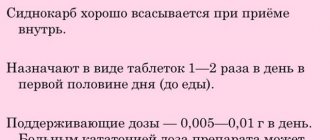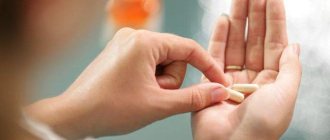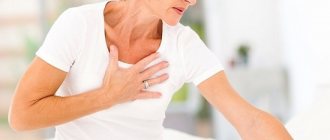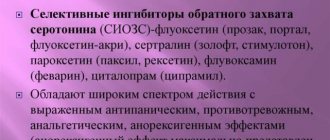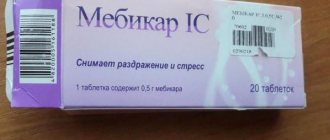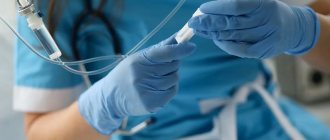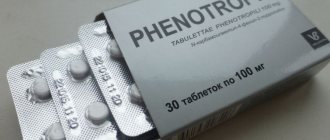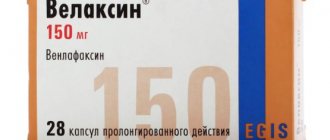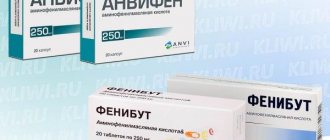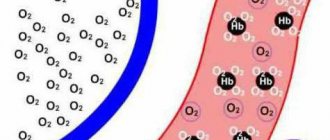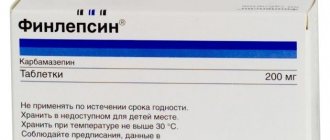Composition of the product and release form
The pharmaceutical industry produces Tiapride in two forms:
- tablets for oral administration;
- injection.
Tablets of the most common type: white, flat, odorless. One side has a stripe that seems to divide the tablet into 4 parts, the other side has the letters “T100”.
One tablet contains 100 mg of the active substance (tiapride) and additional components.
The drug is packaged in plastic transparent blisters, packed in cardboard boxes. One blister contains 10 tablets.
There is a second type of packaging: the same cardboard boxes, but inside there are not blisters, but opaque glass jars, each containing 30 tablets.
One ampoule contains 100 mg of tiapride and additional components. Glass ampoules are placed in plastic cell packaging. One such package includes 6 ampoules. Each ampoule contains 2 ml of pharmaceutical preparation.
Symptoms and treatment of overdose
Symptomatic signs of an overdose of Tiapridal appear as:
- depression of the central nervous system;
- increased blood pressure;
- dysfunction of the extrapyramidal nervous system;
- increased drowsiness and rapid increase in feeling of fatigue;
- comatose state.
To relieve symptoms of overdose you must:
- abruptly discontinue the use of Tiapridal;
- take a medication that provokes the development of a gag reflex;
- carry out therapy aimed at eliminating the symptoms of intoxication with parallel monitoring of the functioning of vital organs and systems.
Until now, no specific antidote has been developed.
Patients with clinical signs of overdose should be closely monitored by medical professionals.
Pharmacological profile
Tiapride is positioned as a drug that does not cause, or almost does not cause, adverse reactions, equally suitable for adults and children.
The mechanism of action of the drug is based on blocking receptors in various sectors of the brain:
- the decrease in body temperature occurs due to the thermoregulation center located in the hypothalamus;
- relief of severe attacks of vomiting is ensured by blocking the receptors of the vomiting center;
- the antipsychotic effect is achieved by blocking the recipes responsible for the production of dopamine, the hormone that “promises joy”.
Additionally, the medication is able to act on dopamine receptors, and also controls the “release” of dopamine; it is equally effective both with its deficiency and with its excess.
Neurotransmitters affected by antipsychotics
Both doctors and patients who have used Tiapride note its pronounced analgesic and hypnotic effect. The analgesic effect is so powerful that the medicine is successfully used to relieve pain attacks in cancer patients.
The medicine is also used for the complex treatment of alcoholism, depression, and opium addiction. At the same time, acting as a catalyst, it enhances the effect of other antipsychotic drugs.
The degree of absorption of the active substance is 75%, the therapeutic effect is further enhanced if the drug is taken before meals. When taking 200 mg in tablet form, its highest concentration in the blood occurs after an hour, when administering a solution - after 30 minutes.
In older patients, the degree of absorption decreases. The drug is excreted by the kidneys and 70% is found unchanged in the urine.
Tiapride underwent clinical studies, as a result of which its ability to overcome the protective barrier of the placenta was recorded. During pregnancy, therefore, this medicine is not prescribed.
Pharmacodynamics and pharmacokinetics
The therapeutic effect of the composition is achieved due to its selective blocking effect on dopamine receptors in the hypothalamus, limbic and cortical parts of the central nervous system. With all this, the medication does not depress the patient’s consciousness and does not have a detrimental effect on his level of intelligence. Taking the composition, on the contrary, can restore clarity of thinking to older people.
The therapeutic effect of the composition is achieved due to its selective blocking effect on dopamine receptors in the hypothalamus.
After intramuscular administration of the drug in a volume of 200 mg of the active substance, the maximum concentration of tiapride is recorded after half an hour. When taking the same volume of the drug orally in the form of Tiapridal tablets, the time increases to 1 hour. When the composition is administered parenterally, its content in the blood plasma is twice as high as that characteristic for oral administration of the drug.
When using Tiaprid tablets, the bioavailability of the main component is 75%. The data can be increased to 95% if you take the medicine right before meals. This technique also increases the concentration of the active substance in the blood plasma by 40%.
It takes less than an hour to distribute the composition in the body. Tiapride crosses the placenta and blood-brain barrier, and in theory it passes into the milk of a nursing woman. The active substance does not accumulate in tissues. It is poorly processed and is excreted mainly by the kidneys. Up to 70% of the main component is found in urine unchanged. In women, the half-life of the drug is about 3 hours, in men it is 30-40 minutes longer.
The medicine is excreted mainly by the kidneys.
Indications for use
The medication in one dosage form or another is prescribed to patients of different age groups.
Application in tablet form
Tiapride tablets for adults are prescribed for:
- correction of behavioral reactions in age-related dementia;
- relief of constant severe pain attacks in cancer patients;
- eliminating pain in depression;
- relief of joint pain and headaches;
- reducing agitation and attacks of aggression in alcoholic illness.
Adult patients and children (after 6 years) with:
- chorea: chronic, secondary, mixed, etc.;
- manifestations of aggression and agitation in children;
- Gilles de la Tourette syndrome.
Purpose of the solution
The solution for intramuscular and intravenous administration is used for the following diagnoses:
- Parkinson's disease;
- chorea and tics;
- tremors of the limbs - tremor;
- alcohol psychosis and withdrawal syndrome;
- for the purpose of behavior correction in elderly patients.
Synonyms of nosological groups
| Category ICD-10 | Synonyms of diseases according to ICD-10 |
| F10.3 Withdrawal state | Alcohol withdrawal syndrome |
| Withdrawal syndrome | |
| Withdrawal syndrome in alcoholism | |
| Abstinence | |
| Alcohol withdrawal | |
| Alcohol withdrawal | |
| Alcohol withdrawal state | |
| Alcohol withdrawal syndrome | |
| Post-withdrawal disorder | |
| Post-withdrawal state | |
| Hangover syndrome | |
| Withdrawal syndrome | |
| Alcohol withdrawal syndrome | |
| Alcohol withdrawal syndrome | |
| Withdrawal state | |
| F10.4 Withdrawal state with delirium | Alcohol delirium |
| Alcoholic delirium tremens | |
| Delirium | |
| Delirious state in alcoholism and drug addiction | |
| F10.5 Alcoholic psychosis | Alcoholic hallucinosis |
| Alcohol psychosis | |
| Alcoholic delirium tremens | |
| Delirium | |
| Delirium in alcoholism | |
| Delirious state in alcoholism and drug addiction | |
| Acute alcoholic psychosis | |
| Acute alcoholic psychosis with autonomic disorders | |
| Psychoorganic syndrome in chronic alcoholism | |
| G10 Huntington's disease | Huntington's disease (chorea) |
| Huntington's chorea | |
| Gettington's chorea | |
| Chorea degenerative | |
| Chorea hereditary | |
| Progressive chronic chorea | |
| G25 Other extrapyramidal and movement disorders | Cerebellar movement disorders |
| Pyramidal spastic paresis | |
| Defeat of the pyramidal system | |
| Damage to the extrapyramidal system | |
| Lesions of the extrapyramidal system | |
| Extrapyramidal disorders | |
| Extrapyramidal hyperkinesis | |
| R45.1 Restlessness and agitation | Agitation |
| Anxiety | |
| Explosive excitability | |
| Internal excitement | |
| Excitability | |
| Excitation | |
| Excitement is acute | |
| Psychomotor agitation | |
| Hyperexcitability | |
| Motor excitement | |
| Relief of psychomotor agitation | |
| Nervous excitement | |
| Restlessness | |
| Night restlessness | |
| Acute stage of schizophrenia with agitation | |
| Acute mental agitation | |
| Paroxysm of excitement | |
| Overexcitement | |
| Increased excitability | |
| Increased nervous excitability | |
| Increased emotional and cardiac excitability | |
| Increased arousal | |
| Mental excitement | |
| Psychomotor agitation | |
| Psychomotor agitation | |
| Psychomotor agitation | |
| Psychomotor agitation in psychosis | |
| Psychomotor agitation of an epileptic nature | |
| Psychomotor paroxysm | |
| Psychomotor seizure | |
| Symptoms of arousal | |
| Symptoms of psychomotor agitation | |
| State of agitation | |
| State of anxiety | |
| State of excitement | |
| A state of heightened anxiety | |
| State of psychomotor agitation | |
| States of anxiety | |
| States of arousal | |
| State of agitation in somatic diseases | |
| State of excitement | |
| Feeling restless | |
| Emotional excitement | |
| R45.6 Physical aggressiveness | Aggressive behavior |
| Aggressive state | |
| Aggressiveness | |
| Aggressive states | |
| Aggression | |
| Auto aggression | |
| R52.1 Persistent, intractable pain | Pain syndrome in oncological practice |
| Severe pain syndrome | |
| Pain syndrome in malignant neoplasms | |
| Pain syndrome in cancer | |
| Pain syndrome with tumors | |
| Pain syndrome in cancer patients | |
| Pain due to malignant neoplasms | |
| Pain due to malignant tumors | |
| Pain due to tumors | |
| Pain in cancer patients | |
| Pain with bone metastases | |
| Pain due to cancer | |
| Malignant pain syndrome | |
| Intense chronic pain | |
| Intense pain syndrome | |
| Intense intractable pain syndrome | |
| Intense chronic pain syndrome | |
| Intractable pain | |
| Intractable pain | |
| Tumor pain | |
| Post-traumatic pain syndrome | |
| Severe pain | |
| Chronic pain | |
| Chronic pain syndrome | |
| R52.2 Other persistent pain | Pain syndrome of non-rheumatic origin |
| Pain syndrome with vertebrogenic lesions | |
| Pain syndrome with neuralgia | |
| Pain syndrome from burns | |
| Pain syndrome is mild or moderate | |
| Neuropathic pain | |
| Neuropathic pain | |
| Perioperative pain | |
| Moderate to severe pain | |
| Moderate or mild pain syndrome | |
| Moderate to severe pain syndrome | |
| Ear pain due to otitis media |
Contraindications for use
Tiapride has absolute and conditional contraindications. Unconditional contraindications to the use of the drug in any form are:
- patient intolerance to any component of the drug;
- established or suspected pheochromocytoma;
- pregnancy in the first trimester (penetration of the active ingredient through the placental barrier has been established);
- sudden surges in pressure; hypertensive crisis;
- breast-feeding;
- the presence of certain types of tumors in the patient, as well as suspicion of them, it is worth noting that this mainly concerns prolactin-dependent neoplasms, due to the fact that tiapride affects the production of prolactin, and this in turn affects the entire hormonal sphere;
- age group of children under 6 years old.
Article on the topic: Synkinesis in neurological practice: diagnosis and treatment
There are a number of conditions for which the medication can be used, but with extreme caution:
- diseases of the heart and cardiovascular system - due to the threat of the risk of developing and intensifying ischemic disorders against the background of low blood pressure;
- in old age, the drug is prescribed with caution due to the possible occurrence of sedation - a relaxed and peaceful state, almost half asleep;
- senile dementia;
- identified patient predisposition to stroke;
- renal failure (the use of the drug is possible with careful adherence to dosage);
- epilepsy (the property of neuroleptics to reduce the epileptogenic threshold is taken into account);
- established thromboembolism or the possibility of its occurrence;
- pregnancy;
- children's age, due to insufficient knowledge of the action of the active component of the drug;
- adolescents - pharmaceuticals may have an undesirable effect on the endocrine system;
- simultaneous use by the patient of ethanol-containing medications.
The patient's presence of arrhythmia or the possibility of its occurrence, electrolyte imbalance and slow heartbeat may also limit the use of Tiapride. In these cases, the drug can provoke severe ventricular heart rhythm disturbances and the occurrence of ventricular tachycardia.
Pharmacodynamics of "Tiapridal"
The drug has antipsychotic, analgesic and anxiolytic effects. As the instructions for use show, Tiapridal selectively blocks the functioning of central dopamine D2 receptors. In this case, there is no effect on D1 receptors. The drug allows you to get rid of dyskinesia, and when used in old age, improves thinking.
Instructions for use
Regardless of the form (tablets or injection solution), the initial doses are always minimal. During subsequent examinations of the patient, the doctor either leaves the dosage the same or increases it.
Depending on the condition and age of the patient, the severity of his condition, concomitant diseases, 25 to 1800 mg of Tiapride per day is prescribed.
The daily dose is usually taken 2-3 times (in severe cases, the drug is administered 4 to 6 times a day).
Course of treatment and dosage for adult patients
Taking the medication in tablet form:
- Constant pain of various nature : the daily norm is 200-400 mg.
- Excitement, attacks of aggression and anger in alcoholism and related disorders . The maximum amount is 200-300 mg per day. Application period – 30-60 days.
- Chorea, Gilles de la Tourette's syndrome . Adult dose 300-800 mg. The initial amount of the drug taken is minimal - 25 mg per day. The most effective dose is established gradually by increasing it step by step.
For elderly patients, the daily amount of medication 200-300 mg is achieved gradually. The first doses are 50 mg twice a day. As prescribed by the doctor, the dose can be increased by 50-100 mg every 2-3 days. In this case, the average dose will be 200 mg, and the maximum allowable dose will be 300 mg.
The solution for intramuscular and intravenous administration is prescribed only to adult patients:
- for constant severe pain, including cancer: 200-400 mg per day;
- in case of qualitative disturbances of consciousness, delirium, predelirious state, the patient is administered in parts from 200 to 1200 mg of medication per day, the interval is 4-6 hours, and in severe cases the dose can be increased to 1800 mg per day.
Children's dosages
Tiapride tablets are prescribed to children over 6 years of age:
- Gilles de la Tourette syndrome, chorea of various types and origins: 3-6 mg/kg per day (children over 6 years old);
- aggression and agitation: 100-150 mg per day (children over 6 years old).
The injection solution for the same indications is administered in an amount of 100-150 mg per day. As prescribed by the doctor, the dose can be increased, but it cannot exceed 300 mg per day (children over 7 years old).
Compared to other medications of similar action, the side effects of Tiapride are much less pronounced; this property makes it possible to use it in child neurology and psychiatry.
For severe chronic and motor tics, the medication is prescribed in an amount sufficient to relieve attacks. Here it is especially important to comply with the conditions for gradual withdrawal of the drug. Dose reduction and then complete withdrawal are carried out within 6-12 months.
Side effects and cases of overdose
Side effects of the drug can affect the nervous system, sensory organs, urinary and reproductive systems.
From the nervous system and sensory organs:
- fast fatiguability;
- drowsiness or agitation;
- involuntary movements of the eyes and eyelids;
- spasms;
- somatic and vegetative disorders.
From the urinary and reproductive systems the following may be observed:
- gynecomastia;
- frigidity;
- impotence.
Cases of overdose
In case of an overdose of tablets, the following are observed:
- state of “half-asleep”, drowsiness and drowsiness;
- possible onset of coma;
- a sharp decrease in blood pressure.
Mostly, an overdose of the solution is characterized by:
- exceeding the norm of sedation several times;
- decreased heart rate and sharp decrease in blood pressure, fainting.
In such cases, it is necessary to stop taking the medication, washing procedures, therapeutic measures aimed at detoxifying the body, and plasmapheresis are carried out.
Any excess of the dosage prescribed by the attending physician leads to dire consequences. For example, if a doctor prescribes 2 tablets and the patient takes 4, the body's reaction may be unpredictable.
Overdose
Violation of the rules of therapy can lead to an overdose. In the case of solution and tablets, the risks of developing an emergency condition are approximately equal and equally dangerous. The clinical picture of drug poisoning is characterized by pathological drowsiness and a drop in blood pressure. The patient experiences an overly pronounced sedative effect of the drug, and there is an obvious change in motor activity due to problems with muscle tone. The victim's consciousness is depressed and coma may develop.
No antidote for the substance tiapride has been found. Hemodialysis will not help against this background. Treatment consists of discontinuing the medication and gastric lavage in the case of taking pills. Next, the patient is provided with symptomatic care, and intensive detoxification measures are carried out.
All manipulations are performed under the control of vital signs of the body. If motor activity is impaired, anticholinergic drugs are additionally prescribed. The patient should remain in the hospital until the symptoms of overdose completely disappear.
special instructions
During the course of taking Tiapride, alcohol is strictly prohibited. In addition, even ethanol-containing drugs prescribed by a doctor are taken with great caution. To avoid life-threatening situations for the driver and passengers, you should refrain from driving, active sports and activities that require increased attention and immediate reaction.
Article on the topic: Diagnosis of liver cirrhosis: methods and tests
Tiapride is never used simultaneously with Levodopa, drugs that slow the heart rate and cause bradycardia. The medicine should not be taken with pharmaceuticals that affect the electrolyte balance of the body or with laxatives. If a situation arises when these drugs are necessary for health reasons, careful medical supervision of the patient is carried out.
Subject to all safety precautions, Tiapride is used in conjunction with antiparkinsonian drugs and morphine.
Ethanol enhances the sedative effect of all antipsychotics. During the course of treatment, alcoholic beverages are prohibited and medications containing ethanol are used with great caution.
Prescription for liver and kidney failure
Due to very little metabolism, no dosage changes are required for liver dysfunction.
In renal failure, a different picture is observed. The amount of the drug taken directly depends on creatinine clearance (C/C):
- with C/C 30-60 ml/min, the standard dose is reduced by 25%;
- with C/C 10-30 ml/min – the amount of the drug taken is reduced by 2 times;
- with C/C 10 ml/min, the dose is reduced by 4 times compared to the standard dose prescribed for normal functioning of the organ.
Prescription during pregnancy and lactation
The protective placental barrier is not an obstacle to the active component of the antipsychotic. This is especially true for pregnancy in the first trimester. If the use of the drug is necessary for health reasons, if the risks are justified, Tiapride is prescribed after a thorough examination of the patient, administration is carried out under constant medical supervision, and the quantity and duration of administration is reduced to the minimum possible.
No doctor can guarantee one hundred percent health of the baby when the expectant mother takes antipsychotic medications. If the patient took Tiapride for a long time during pregnancy, the newborn comes under the supervision of pediatric neurologists from the first days of life.
It is not known whether the active ingredient can pass into the milk of a nursing woman. But there is evidence from experiments on animals that have documented this ability. The consequences for the child are not predicted, and there are two possible solutions - either completely stop taking the antipsychotic, or reduce the dosage as much as possible.
Contraindications and restrictions for taking the drug "Tiapridal"
The instructions for use prohibit Tiapridal from being prescribed to children under six years of age. In pediatrics, therapy is carried out only with tablets. The drug should not be used by pregnant women and patients who are breastfeeding. The medication is not used in case of hypersensitivity to its components or other similar agents. Contraindications include the following conditions:
- liver and kidney failure, which is significant;
- diagnosis of a prolactin-dependent neoplasm, suspicion of its presence;
- hypertensive crisis;
- diagnosis of pheochromocytoma, suspicion of its presence.
Tablets and solution are not used together with Sultopride and dopamine receptor agonists (the exception is the treatment of patients with Parkinson's disease), and are not combined with certain types of neuroleptics, antiarrhythmic drugs belonging to classes III and I A.
The instructions do not allow treatment with the drug "Tiapridal" simultaneously with the use of "Moxifloxacin", "Sparfloxacin", "Difemanil", "Erythromycin", "Bepridil", "Mizolastin", "Levadopa", "Cisapride" and with the intravenous administration of "Vincamine" .
If a patient (especially an elderly patient) is being treated with drugs that can lead to the development of hypokalemia, deterioration of cardiac conduction, prolongation of the QT interval, or severe bradycardia, Tiapridal should be used with caution. Caution is also required in the following cases:
- Parkinson's disease;
- prolongation of the QT interval of a congenital nature;
- hypokalemia;
- chronic course of renal failure;
- bradycardia;
- diseases in which the functioning of the cardiovascular system is disrupted (stage of decompensation);
- epilepsy.
From application practice
On the Internet there are opinions of doctors and patients who have used Tiapride, there are tips for use, positive and negative reviews.
The drug significantly reduces or completely eliminates tics, relieves anxiety and hyperexcitability. Equally well tolerated by children and elderly patients. Side effects are rare and, compared to other antipsychotics, are much less pronounced.
Psychiatrist, Saratov
Tiapride is an excellent drug, but its price has been greatly increased. Many people couldn't afford it. Cheaper analogues either have a lot of side effects or are many times inferior in terms of therapeutic effect.
Psychiatrist. Tomsk city
The child was prescribed medication for tics - it helped.
Marina
The drug is serious. Taking without a doctor's prescription is dangerous. I checked it for myself!
"Pianist"
Powerful medicine. Anxiety and irritability are gone, sleep is wonderful. What did you get in return? Stiffness in movement, problems with speech - minor, but true. In general, the drug is quite mild compared to the same Aminazine. Yes, and one more thing - the analgesic effect is excellent.
Freegabalin
Helps well with alcohol addiction.
Filin. Paramedic 03
Judging by the reviews and opinion of doctors, the drug has more advantages than disadvantages. Both doctors and those who have used Tiapride advise starting with the smallest doses and stopping it gradually.
Before starting a course of treatment, for example, for a state of constant anxiety, first find out exactly the nature of its occurrence. Do not neglect consultations with psychologists and psychotherapists.
Do not expect an immediate improvement in memory when taking Tiapride - the effect of the drug is cumulative; in order for it to fully manifest itself, several days must pass.
Another problem that worries many is an increase in prolactin levels. Patients note a significant “surge” of the hormone, disruptions in the menstrual cycle, which are fraught with serious female diseases.
What to replace the medicine with?
Similar in action are Haloperidol, Aminazine, Azapine, Quetiapine. But these drugs are stronger and have more side effects.
Speaking about analogues, we should mention Eglonil, Betamax and the Russian-made drug Tiapridal, in which the active substance is the same as in Tiapride.
The instructions mention that analogues are selected when the original cannot be used in conjunction with other prescribed drugs, when side effects are too pronounced, or when the therapeutic effect does not correspond to the expected result.
Interaction
Combination with Levodopa, Cabergoline and Quinagolide may lead to mutual antagonism.
Simultaneous use with beta-blockers, for example, Verapamil or Diltiazem, as well as Clonidine, Guanfacine and Digitalis preparations can lead to the development of bradycardia. Potassium-sparing diuretics, Amphotericin B, glucocorticosteroids
often
causes hypokalemia.
It is not recommended to combine this drug with Pimozide, Sultopride, Sulpiride, Haloperidol, Thioridazine, Methadone, Amisulpride, Droperidol, Chlorpromazine, Levomepromazine, Cyamemazine, Pipotiazine, Sertindole, Veraliprid, antidepressants, Imipramine derivatives, lithium preparations, Bepridil, cisapride, Dipheman sludge, methyl sulfate, intravenously administered Erythromycin, Spiramycin, Mizolastin, Vincamine and other drugs of similar action.
When it is not possible to avoid the simultaneous administration of these drugs and Tiapride, careful clinical, laboratory and electrocardiographic monitoring is necessary.

